JEEP RENEGADE 2018 Owner handbook (in English)
Manufacturer: JEEP, Model Year: 2018, Model line: RENEGADE, Model: JEEP RENEGADE 2018Pages: 356, PDF Size: 6.11 MB
Page 101 of 356
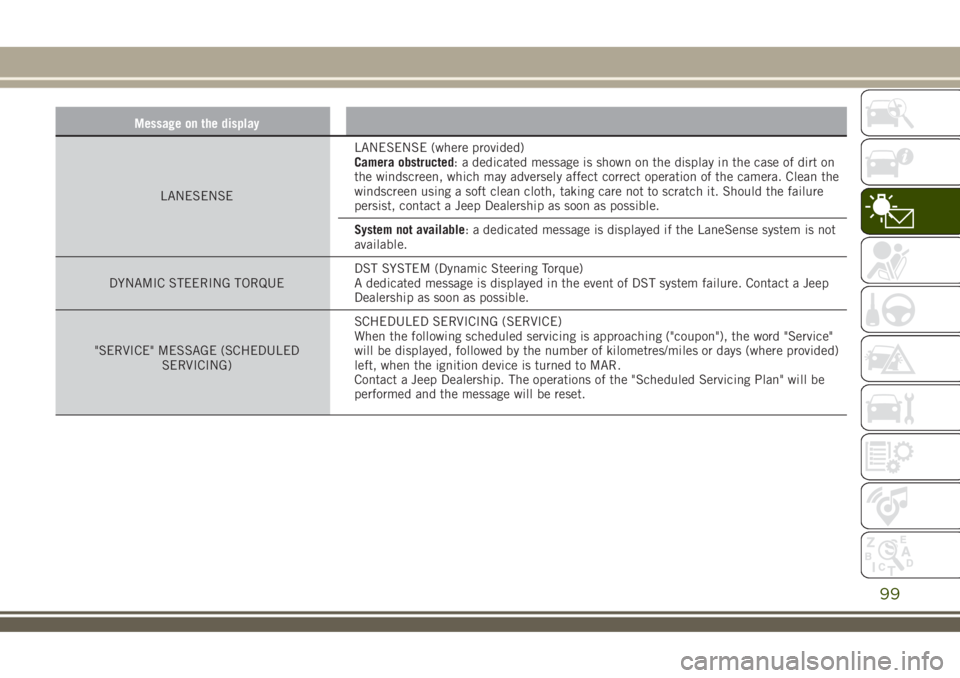
Message on the display
LANESENSELANESENSE (where provided)
Camera obstructed: a dedicated message is shown on the display in the case of dirt on
the windscreen, which may adversely affect correct operation of the camera. Clean the
windscreen using a soft clean cloth, taking care not to scratch it. Should the failure
persist, contact a Jeep Dealership as soon as possible.
System not available: a dedicated message is displayed if the LaneSense system is not
available.
DYNAMIC STEERING TORQUEDST SYSTEM (Dynamic Steering Torque)
A dedicated message is displayed in the event of DST system failure. Contact a Jeep
Dealership as soon as possible.
"SERVICE" MESSAGE (SCHEDULED
SERVICING)SCHEDULED SERVICING (SERVICE)
When the following scheduled servicing is approaching ("coupon"), the word "Service"
will be displayed, followed by the number of kilometres/miles or days (where provided)
left, when the ignition device is turned to MAR.
Contact a Jeep Dealership. The operations of the "Scheduled Servicing Plan" will be
performed and the message will be reset.
99
Page 102 of 356

Page 103 of 356
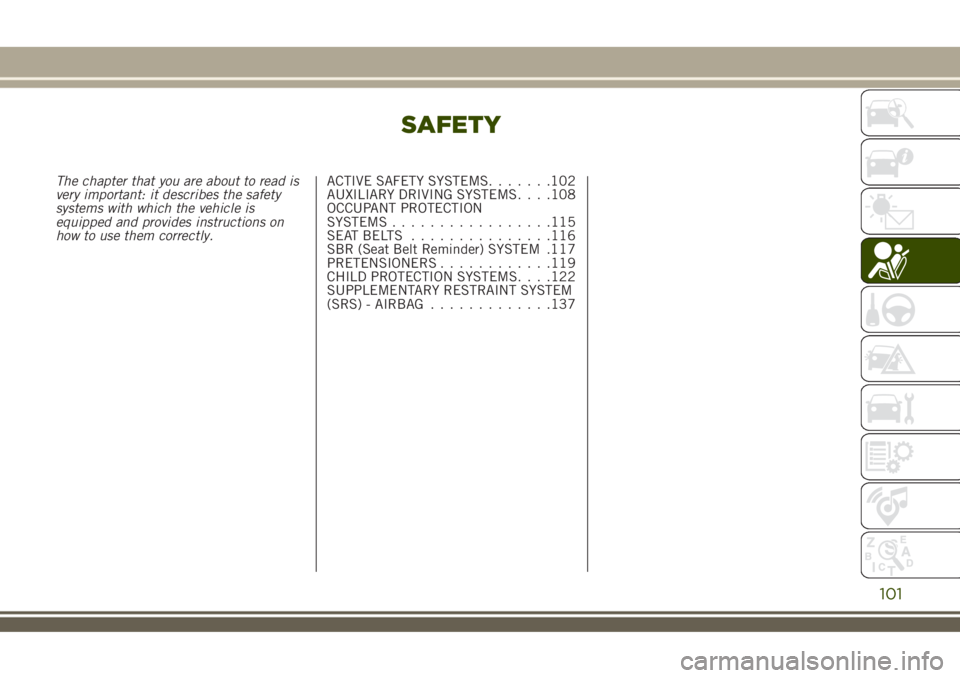
SAFETY
The chapter that you are about to read is
very important: it describes the safety
systems with which the vehicle is
equipped and provides instructions on
how to use them correctly.ACTIVE SAFETY SYSTEMS.......102
AUXILIARY DRIVING SYSTEMS. . . .108
OCCUPANT PROTECTION
SYSTEMS.................115
SEATBELTS ...............116
SBR (Seat Belt Reminder) SYSTEM .117
PRETENSIONERS............119
CHILD PROTECTION SYSTEMS. . . .122
SUPPLEMENTARY RESTRAINT SYSTEM
(SRS) - AIRBAG.............137
101
Page 104 of 356
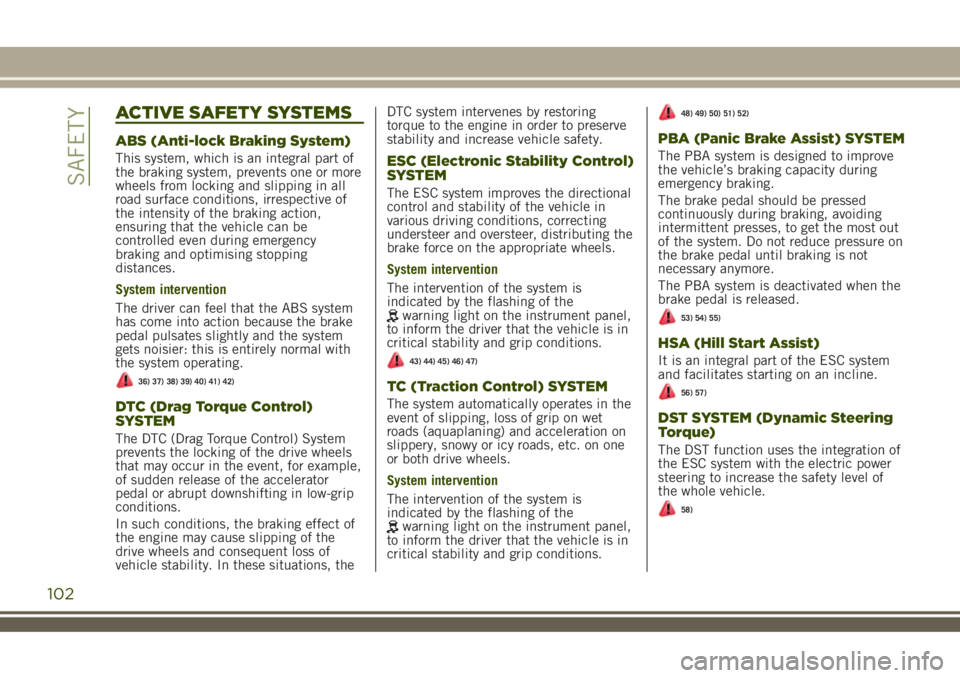
ACTIVE SAFETY SYSTEMS
ABS (Anti-lock Braking System)
This system, which is an integral part of
the braking system, prevents one or more
wheels from locking and slipping in all
road surface conditions, irrespective of
the intensity of the braking action,
ensuring that the vehicle can be
controlled even during emergency
braking and optimising stopping
distances.
System intervention
The driver can feel that the ABS system
has come into action because the brake
pedal pulsates slightly and the system
gets noisier: this is entirely normal with
the system operating.
36) 37) 38) 39) 40) 41) 42)
DTC (Drag Torque Control)
SYSTEM
The DTC (Drag Torque Control) System
prevents the locking of the drive wheels
that may occur in the event, for example,
of sudden release of the accelerator
pedal or abrupt downshifting in low-grip
conditions.
In such conditions, the braking effect of
the engine may cause slipping of the
drive wheels and consequent loss of
vehicle stability. In these situations, theDTC system intervenes by restoring
torque to the engine in order to preserve
stability and increase vehicle safety.
ESC (Electronic Stability Control)
SYSTEM
The ESC system improves the directional
control and stability of the vehicle in
various driving conditions, correcting
understeer and oversteer, distributing the
brake force on the appropriate wheels.
System intervention
The intervention of the system is
indicated by the flashing of the
warning light on the instrument panel,
to inform the driver that the vehicle is in
critical stability and grip conditions.
43) 44) 45) 46) 47)
TC (Traction Control) SYSTEM
The system automatically operates in the
event of slipping, loss of grip on wet
roads (aquaplaning) and acceleration on
slippery, snowy or icy roads, etc. on one
or both drive wheels.
System intervention
The intervention of the system is
indicated by the flashing of the
warning light on the instrument panel,
to inform the driver that the vehicle is in
critical stability and grip conditions.
48) 49) 50) 51) 52)
PBA (Panic Brake Assist) SYSTEM
The PBA system is designed to improve
the vehicle’s braking capacity during
emergency braking.
The brake pedal should be pressed
continuously during braking, avoiding
intermittent presses, to get the most out
of the system. Do not reduce pressure on
the brake pedal until braking is not
necessary anymore.
The PBA system is deactivated when the
brake pedal is released.
53) 54) 55)
HSA (Hill Start Assist)
It is an integral part of the ESC system
and facilitates starting on an incline.
56) 57)
DST SYSTEM (Dynamic Steering
Torque)
The DST function uses the integration of
the ESC system with the electric power
steering to increase the safety level of
the whole vehicle.
58)
102
SAFETY
Page 105 of 356
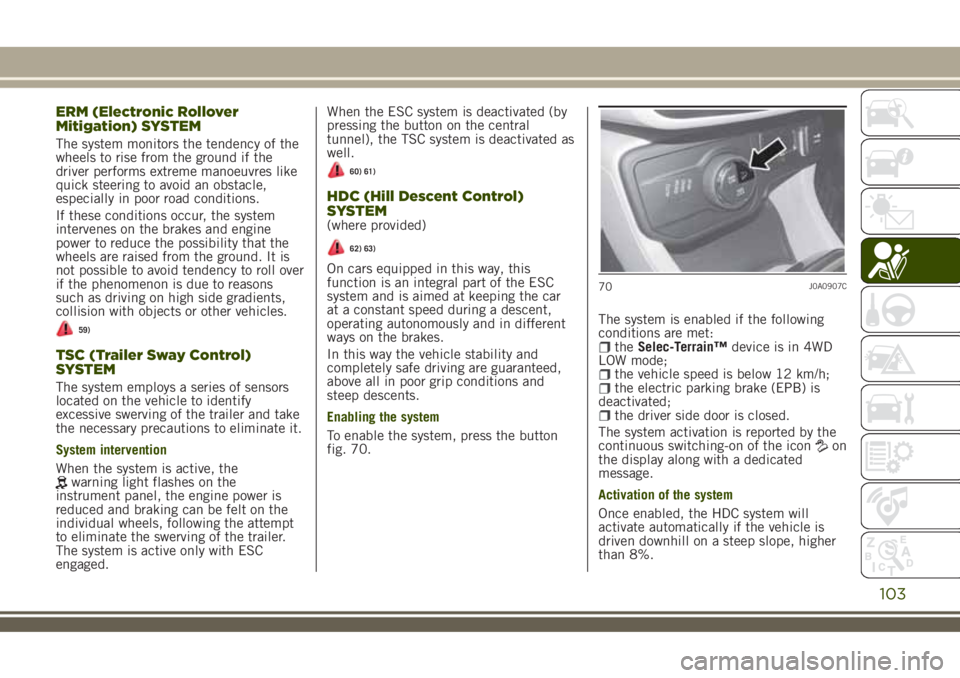
ERM (Electronic Rollover
Mitigation) SYSTEM
The system monitors the tendency of the
wheels to rise from the ground if the
driver performs extreme manoeuvres like
quick steering to avoid an obstacle,
especially in poor road conditions.
If these conditions occur, the system
intervenes on the brakes and engine
power to reduce the possibility that the
wheels are raised from the ground. It is
not possible to avoid tendency to roll over
if the phenomenon is due to reasons
such as driving on high side gradients,
collision with objects or other vehicles.
59)
TSC (Trailer Sway Control)
SYSTEM
The system employs a series of sensors
located on the vehicle to identify
excessive swerving of the trailer and take
the necessary precautions to eliminate it.
System intervention
When the system is active, the
warning light flashes on the
instrument panel, the engine power is
reduced and braking can be felt on the
individual wheels, following the attempt
to eliminate the swerving of the trailer.
The system is active only with ESC
engaged.When the ESC system is deactivated (by
pressing the button on the central
tunnel), the TSC system is deactivated as
well.
60) 61)
HDC (Hill Descent Control)
SYSTEM
(where provided)
62) 63)
On cars equipped in this way, this
function is an integral part of the ESC
system and is aimed at keeping the car
at a constant speed during a descent,
operating autonomously and in different
ways on the brakes.
In this way the vehicle stability and
completely safe driving are guaranteed,
above all in poor grip conditions and
steep descents.
Enabling the system
To enable the system, press the button
fig. 70.The system is enabled if the following
conditions are met:
theSelec-Terrain™device is in 4WD
LOW mode;
the vehicle speed is below 12 km/h;the electric parking brake (EPB) is
deactivated;
the driver side door is closed.
The system activation is reported by the
continuous switching-on of the icon
on
the display along with a dedicated
message.
Activation of the system
Once enabled, the HDC system will
activate automatically if the vehicle is
driven downhill on a steep slope, higher
than 8%.
70J0A0907C
103
Page 106 of 356
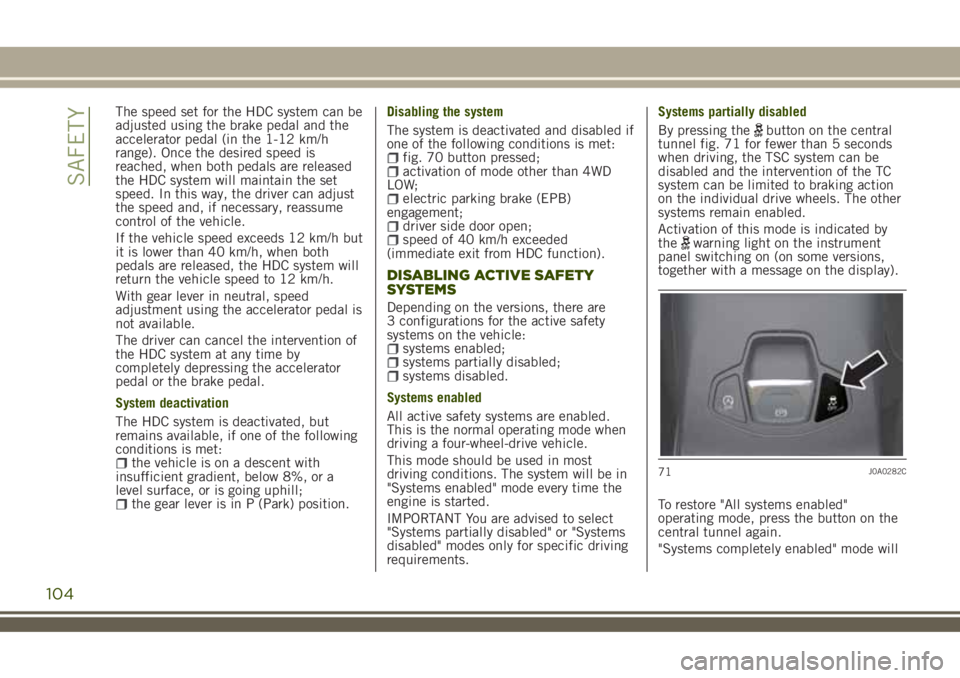
The speed set for the HDC system can be
adjusted using the brake pedal and the
accelerator pedal (in the 1-12 km/h
range). Once the desired speed is
reached, when both pedals are released
the HDC system will maintain the set
speed. In this way, the driver can adjust
the speed and, if necessary, reassume
control of the vehicle.
If the vehicle speed exceeds 12 km/h but
it is lower than 40 km/h, when both
pedals are released, the HDC system will
return the vehicle speed to 12 km/h.
With gear lever in neutral, speed
adjustment using the accelerator pedal is
not available.
The driver can cancel the intervention of
the HDC system at any time by
completely depressing the accelerator
pedal or the brake pedal.
System deactivation
The HDC system is deactivated, but
remains available, if one of the following
conditions is met:
the vehicle is on a descent with
insufficient gradient, below 8%, or a
level surface, or is going uphill;
the gear lever is in P (Park) position.Disabling the system
The system is deactivated and disabled if
one of the following conditions is met:
fig. 70 button pressed;activation of mode other than 4WD
LOW;
electric parking brake (EPB)
engagement;
driver side door open;speed of 40 km/h exceeded
(immediate exit from HDC function).
DISABLING ACTIVE SAFETY
SYSTEMS
Depending on the versions, there are
3 configurations for the active safety
systems on the vehicle:
systems enabled;systems partially disabled;systems disabled.
Systems enabled
All active safety systems are enabled.
This is the normal operating mode when
driving a four-wheel-drive vehicle.
This mode should be used in most
driving conditions. The system will be in
"Systems enabled" mode every time the
engine is started.
IMPORTANT You are advised to select
"Systems partially disabled" or "Systems
disabled" modes only for specific driving
requirements.Systems partially disabled
By pressing the
button on the central
tunnel fig. 71 for fewer than 5 seconds
when driving, the TSC system can be
disabled and the intervention of the TC
system can be limited to braking action
on the individual drive wheels. The other
systems remain enabled.
Activation of this mode is indicated by
the
warning light on the instrument
panel switching on (on some versions,
together with a message on the display).
To restore "All systems enabled"
operating mode, press the button on the
central tunnel again.
"Systems completely enabled" mode will
71J0A0282C
104
SAFETY
Page 107 of 356
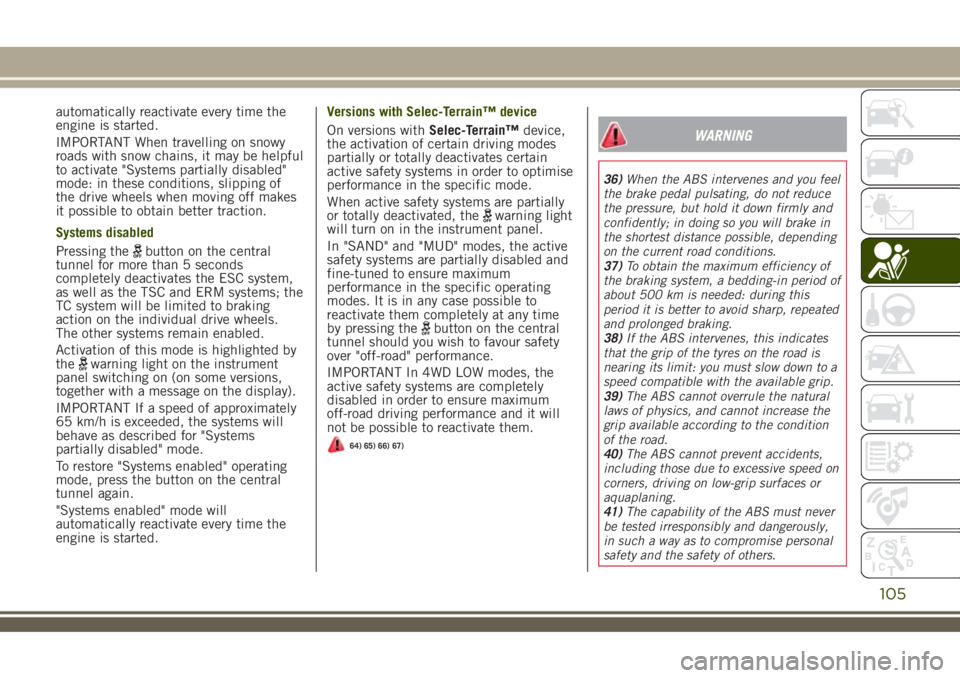
automatically reactivate every time the
engine is started.
IMPORTANT When travelling on snowy
roads with snow chains, it may be helpful
to activate "Systems partially disabled"
mode: in these conditions, slipping of
the drive wheels when moving off makes
it possible to obtain better traction.
Systems disabled
Pressing the
button on the central
tunnel for more than 5 seconds
completely deactivates the ESC system,
as well as the TSC and ERM systems; the
TC system will be limited to braking
action on the individual drive wheels.
The other systems remain enabled.
Activation of this mode is highlighted by
the
warning light on the instrument
panel switching on (on some versions,
together with a message on the display).
IMPORTANT If a speed of approximately
65 km/h is exceeded, the systems will
behave as described for "Systems
partially disabled" mode.
To restore "Systems enabled" operating
mode, press the button on the central
tunnel again.
"Systems enabled" mode will
automatically reactivate every time the
engine is started.Versions with Selec-Terrain™ device
On versions withSelec-Terrain™device,
the activation of certain driving modes
partially or totally deactivates certain
active safety systems in order to optimise
performance in the specific mode.
When active safety systems are partially
or totally deactivated, the
warning light
will turn on in the instrument panel.
In "SAND" and "MUD" modes, the active
safety systems are partially disabled and
fine-tuned to ensure maximum
performance in the specific operating
modes. It is in any case possible to
reactivate them completely at any time
by pressing the
button on the central
tunnel should you wish to favour safety
over "off-road" performance.
IMPORTANT In 4WD LOW modes, the
active safety systems are completely
disabled in order to ensure maximum
off-road driving performance and it will
not be possible to reactivate them.
64) 65) 66) 67)
WARNING
36)When the ABS intervenes and you feel
the brake pedal pulsating, do not reduce
the pressure, but hold it down firmly and
confidently; in doing so you will brake in
the shortest distance possible, depending
on the current road conditions.
37)To obtain the maximum efficiency of
the braking system, a bedding-in period of
about 500 km is needed: during this
period it is better to avoid sharp, repeated
and prolonged braking.
38)If the ABS intervenes, this indicates
that the grip of the tyres on the road is
nearing its limit: you must slow down to a
speed compatible with the available grip.
39)The ABS cannot overrule the natural
laws of physics, and cannot increase the
grip available according to the condition
of the road.
40)The ABS cannot prevent accidents,
including those due to excessive speed on
corners, driving on low-grip surfaces or
aquaplaning.
41)The capability of the ABS must never
be tested irresponsibly and dangerously,
in such a way as to compromise personal
safety and the safety of others.
105
Page 108 of 356
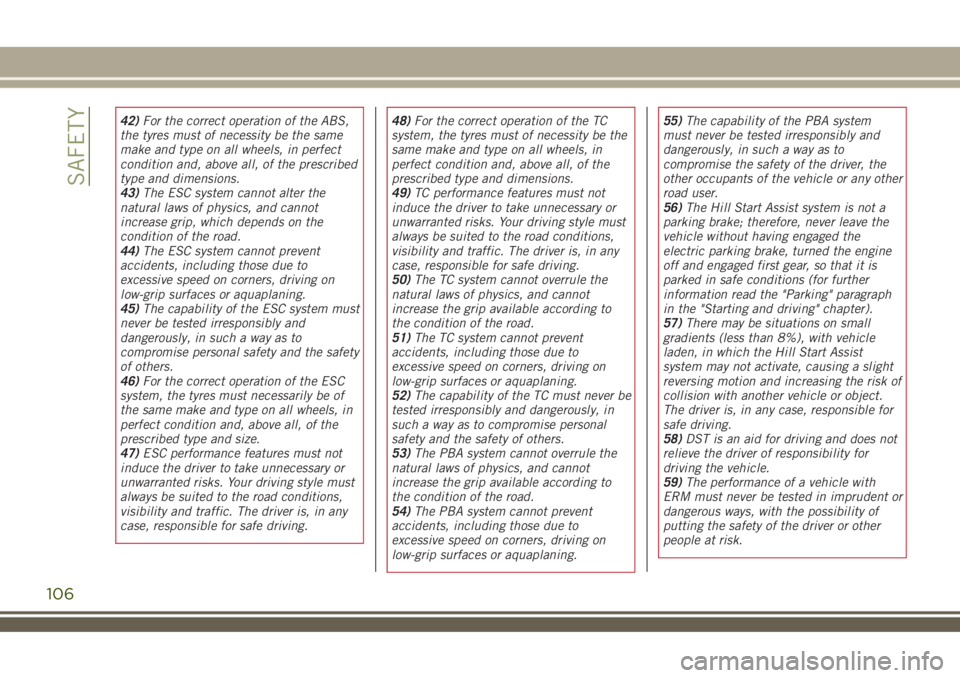
42)For the correct operation of the ABS,
the tyres must of necessity be the same
make and type on all wheels, in perfect
condition and, above all, of the prescribed
type and dimensions.
43)The ESC system cannot alter the
natural laws of physics, and cannot
increase grip, which depends on the
condition of the road.
44)The ESC system cannot prevent
accidents, including those due to
excessive speed on corners, driving on
low-grip surfaces or aquaplaning.
45)The capability of the ESC system must
never be tested irresponsibly and
dangerously, in such a way as to
compromise personal safety and the safety
of others.
46)For the correct operation of the ESC
system, the tyres must necessarily be of
the same make and type on all wheels, in
perfect condition and, above all, of the
prescribed type and size.
47)ESC performance features must not
induce the driver to take unnecessary or
unwarranted risks. Your driving style must
always be suited to the road conditions,
visibility and traffic. The driver is, in any
case, responsible for safe driving.48)For the correct operation of the TC
system, the tyres must of necessity be the
same make and type on all wheels, in
perfect condition and, above all, of the
prescribed type and dimensions.
49)TC performance features must not
induce the driver to take unnecessary or
unwarranted risks. Your driving style must
always be suited to the road conditions,
visibility and traffic. The driver is, in any
case, responsible for safe driving.
50)The TC system cannot overrule the
natural laws of physics, and cannot
increase the grip available according to
the condition of the road.
51)The TC system cannot prevent
accidents, including those due to
excessive speed on corners, driving on
low-grip surfaces or aquaplaning.
52)The capability of the TC must never be
tested irresponsibly and dangerously, in
such a way as to compromise personal
safety and the safety of others.
53)The PBA system cannot overrule the
natural laws of physics, and cannot
increase the grip available according to
the condition of the road.
54)The PBA system cannot prevent
accidents, including those due to
excessive speed on corners, driving on
low-grip surfaces or aquaplaning.55)The capability of the PBA system
must never be tested irresponsibly and
dangerously, in such a way as to
compromise the safety of the driver, the
other occupants of the vehicle or any other
road user.
56)The Hill Start Assist system is not a
parking brake; therefore, never leave the
vehicle without having engaged the
electric parking brake, turned the engine
off and engaged first gear, so that it is
parked in safe conditions (for further
information read the "Parking" paragraph
in the "Starting and driving" chapter).
57)There may be situations on small
gradients (less than 8%), with vehicle
laden, in which the Hill Start Assist
system may not activate, causing a slight
reversing motion and increasing the risk of
collision with another vehicle or object.
The driver is, in any case, responsible for
safe driving.
58)DST is an aid for driving and does not
relieve the driver of responsibility for
driving the vehicle.
59)The performance of a vehicle with
ERM must never be tested in imprudent or
dangerous ways, with the possibility of
putting the safety of the driver or other
people at risk.
106
SAFETY
Page 109 of 356
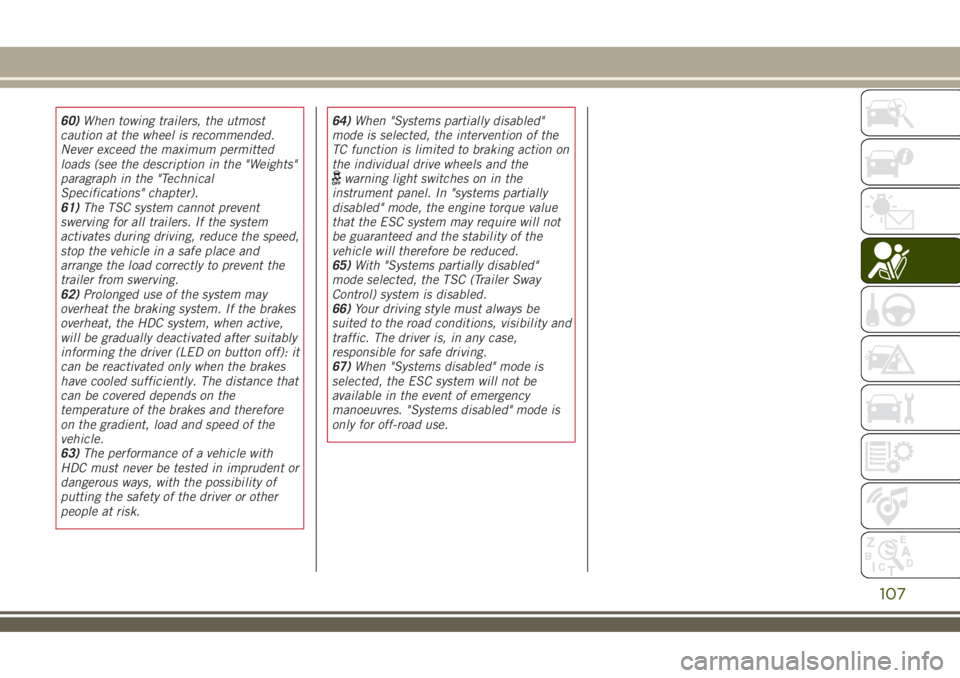
60)When towing trailers, the utmost
caution at the wheel is recommended.
Never exceed the maximum permitted
loads (see the description in the "Weights"
paragraph in the "Technical
Specifications" chapter).
61)The TSC system cannot prevent
swerving for all trailers. If the system
activates during driving, reduce the speed,
stop the vehicle in a safe place and
arrange the load correctly to prevent the
trailer from swerving.
62)Prolonged use of the system may
overheat the braking system. If the brakes
overheat, the HDC system, when active,
will be gradually deactivated after suitably
informing the driver (LED on button off): it
can be reactivated only when the brakes
have cooled sufficiently. The distance that
can be covered depends on the
temperature of the brakes and therefore
on the gradient, load and speed of the
vehicle.
63)The performance of a vehicle with
HDC must never be tested in imprudent or
dangerous ways, with the possibility of
putting the safety of the driver or other
people at risk.64)When "Systems partially disabled"
mode is selected, the intervention of the
TC function is limited to braking action on
the individual drive wheels and the
warning light switches on in the
instrument panel. In "systems partially
disabled" mode, the engine torque value
that the ESC system may require will not
be guaranteed and the stability of the
vehicle will therefore be reduced.
65)With "Systems partially disabled"
mode selected, the TSC (Trailer Sway
Control) system is disabled.
66)Your driving style must always be
suited to the road conditions, visibility and
traffic. The driver is, in any case,
responsible for safe driving.
67)When "Systems disabled" mode is
selected, the ESC system will not be
available in the event of emergency
manoeuvres. "Systems disabled" mode is
only for off-road use.
107
Page 110 of 356
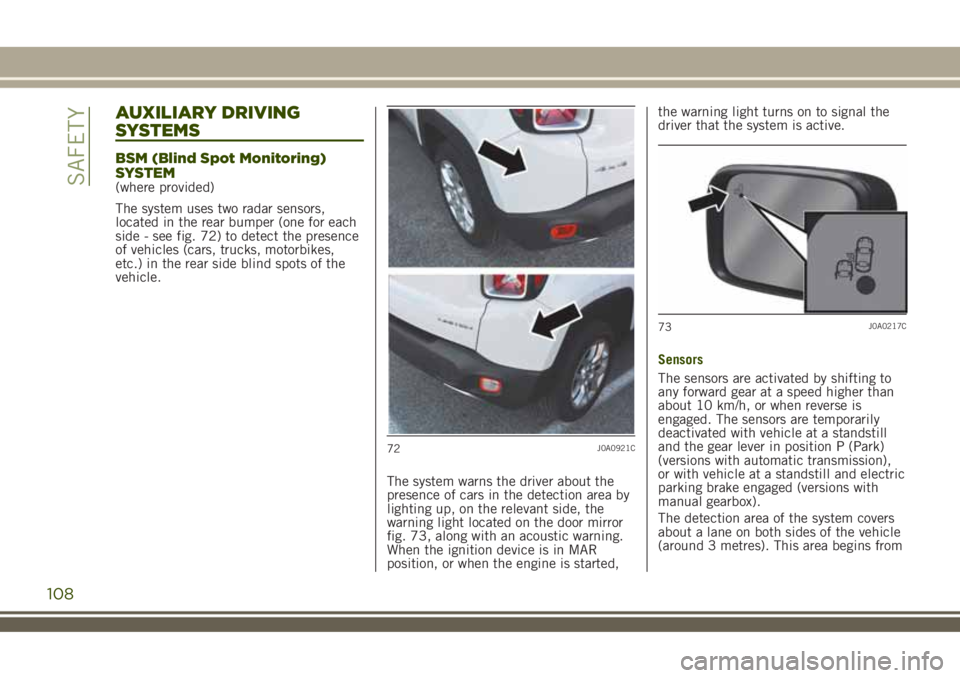
AUXILIARY DRIVING
SYSTEMS
BSM (Blind Spot Monitoring)
SYSTEM
(where provided)
The system uses two radar sensors,
located in the rear bumper (one for each
side - see fig. 72) to detect the presence
of vehicles (cars, trucks, motorbikes,
etc.) in the rear side blind spots of the
vehicle.
The system warns the driver about the
presence of cars in the detection area by
lighting up, on the relevant side, the
warning light located on the door mirror
fig. 73, along with an acoustic warning.
When the ignition device is in MAR
position, or when the engine is started,the warning light turns on to signal the
driver that the system is active.
Sensors
The sensors are activated by shifting to
any forward gear at a speed higher than
about 10 km/h, or when reverse is
engaged. The sensors are temporarily
deactivated with vehicle at a standstill
and the gear lever in position P (Park)
(versions with automatic transmission),
or with vehicle at a standstill and electric
parking brake engaged (versions with
manual gearbox).
The detection area of the system covers
about a lane on both sides of the vehicle
(around 3 metres). This area begins from
72J0A0921C
73J0A0217C
108
SAFETY